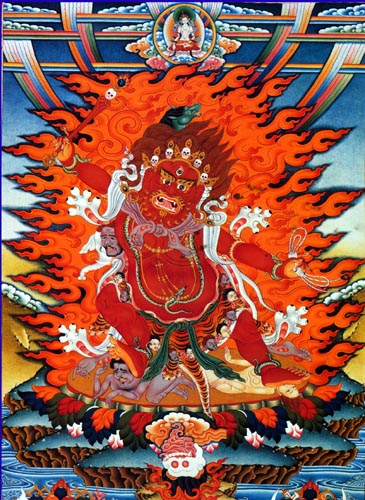Difference between revisions of "Paro Taktsang"
Jump to navigation
Jump to search
Bj Lhundrup (talk | contribs) |
|||
| Line 1: | Line 1: | ||
| − | + | [[Image:Tadren.jpeg|frame|]] | |
---- | ---- | ||
| + | '''Hayagriva''' ([[rta mgrin]]). Tantric deity shown with a horse's head within his flaming hair; wrathful aspect of Buddha [[Amitabha]]. Here identical with [[Padma Heruka]], [[Lotus Speech]], among the [[Eight Sadhana Teachings]] ([[sgrub pa bka' brgyad]]). [RY] | ||
| − | |||
| − | + | [[Category:Tantric Deities]] | |
| − | |||
| − | |||
| − | |||
| − | |||
| − | |||
| − | |||
| − | |||
| − | |||
| − | |||
| − | |||
| − | |||
| − | |||
| − | |||
| − | |||
| − | |||
| − | |||
| − | |||
| − | |||
| − | |||
| − | |||
| − | |||
| − | |||
| − | |||
| − | |||
| − | |||
| − | |||
| − | |||
| − | |||
| − | |||
| − | |||
| − | |||
| − | |||
| − | |||
| − | |||
| − | |||
| − | |||
| − | |||
| − | |||
| − | |||
| − | |||
| − | |||
| − | |||
| − | |||
| − | |||
| − | |||
| − | |||
| − | |||
| − | |||
| − | |||
| − | |||
| − | |||
| − | |||
| − | |||
| − | |||
| − | |||
| − | |||
| − | |||
| − | |||
| − | |||
| − | |||
| − | |||
| − | |||
| − | |||
| − | |||
| − | |||
| − | |||
| − | |||
| − | |||
| − | |||
| − | |||
| − | |||
| − | |||
| − | |||
| − | |||
| − | |||
| − | |||
| − | |||
| − | |||
| − | |||
| − | |||
| − | |||
| − | |||
| − | |||
| − | |||
| − | |||
| − | |||
| − | |||
| − | |||
| − | |||
| − | |||
| − | |||
| − | |||
| − | |||
| − | |||
| − | |||
| − | |||
| − | |||
| − | |||
| − | |||
| − | |||
| − | |||
| − | |||
| − | |||
| − | |||
| − | |||
| − | |||
| − | |||
| − | |||
| − | |||
| − | |||
| − | |||
| − | |||
| − | |||
| − | |||
| − | |||
| − | |||
| − | |||
| − | |||
| − | |||
| − | |||
| − | |||
| − | |||
| − | [[Category: | ||
Revision as of 17:08, 31 October 2008
Hayagriva (rta mgrin). Tantric deity shown with a horse's head within his flaming hair; wrathful aspect of Buddha Amitabha. Here identical with Padma Heruka, Lotus Speech, among the Eight Sadhana Teachings (sgrub pa bka' brgyad). [RY]
